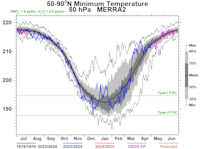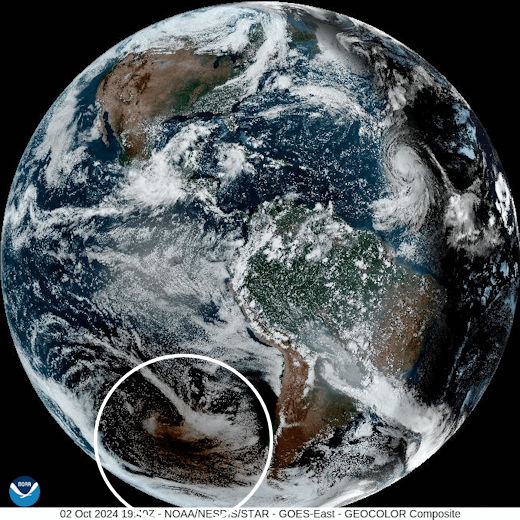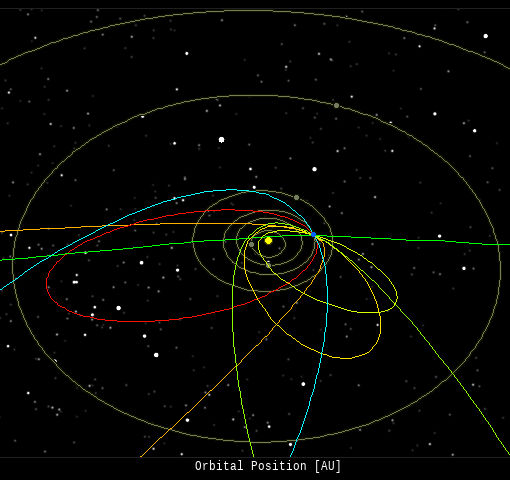 | | | Switch to: Europe, USA, New Zealand, Antarctica Credit: NOAA/Ovation  Planetary K-index Planetary K-index
Now: Kp= 2.33 quiet
24-hr max: Kp= 2.33 quiet
explanation | more data
Interplanetary Mag. Field
Btotal: 6.99 nT
Bz: 2.57 nT north
more data: ACE, DSCOVR
Updated: Today at 1147 UT  Coronal Holes: 04 Oct 24 Coronal Holes: 04 Oct 24 
There are no significant equatorial coronal holes on the Earth-facing side of the sun. Credit: SDO/AIA  Polar Stratospheric Clouds
Colorful Type II polar stratospheric clouds (PSC) form when the temperature in the stratosphere drops to a staggeringly low -85C. NASA's MERRA-2 climate model predicts when the air up there is cold enough: 
On Oct. 04, 2024, the Arctic stratosphere is much too warm for Type II polar stratospheric clouds. | more data. Noctilucent Clouds
The northern season for NLCs is underway--but not for long. The first clouds were detected inside the Arctic Circle on May 25, 2024, by the NOAA 21 satellite. After peaking in July, the clouds are now in rapid decline. This is typical for the month of August, which usually brings the end of NLC season in the northern hemisphere.

Updated: Aug. 28, 2024
An instrument onboard NOAA 21 (OMPS LP) is able to detect NLCs (also known as "polar mesospheric clouds" or PMCs). In the daily map, above, each dot is a detected cloud. As the season progresses, these dots will multiply in number and shift in hue from blue to red as the brightness of the clouds intensifies.
 SPACE WEATHER
NOAA Forecasts | | Updated at: 2024 Oct 04 2200 UTC FLARE | 0-24 hr | 24-48 hr | CLASS M | 75 % | 75 % | CLASS X | 35 % | 35 % |  Geomagnetic Storms: Geomagnetic Storms:
Probabilities for significant disturbances in Earth's magnetic field are given for three activity levels: active, minor storm, severe storm Updated at: 2024 Oct 04 2200 UTC Mid-latitudes | 0-24 hr | 24-48 hr | ACTIVE | 15 % | 15 % | MINOR | 35 % | 35 % | SEVERE | 50 % | 50 % | High latitudes | 0-24 hr | 24-48 hr | ACTIVE | 01 % | 01 % | MINOR | 10 % | 10 % | SEVERE | 85 % | 85 % | | | |  | | | | | | | | | | | This is an AI Free Zone! Text created by Large Language Models is spreading rapidly across the Internet. It's well-written, artificial, frequently inaccurate. If you find a mistake on Spaceweather.com, rest assured it was made by a real human being. | | | CHANCE OF MORE X-FLARES TODAY: The solar disk is filled with big sunspots.There are currently four active regions with unstable 'delta-class' magnetic fields that harbor energy for strong solar flares. NOAA forecasters estimate a 75% chence of M-class flares and a 35% chance of X-flares during the next 24 hours. Solar flare alerts: SMS Text GEOMAGNETIC STORMS THIS WEEKEND: This week, two powerful X-class solar flares (X7.1 and X9.1) and a series of lesser M-flares hurled CMEs toward Earth. A new NOAA model shows three of them hitting or grazing our planet between Oct. 4th and 7th: 
Click to view the animated NOAA model
The most potent CME (#2 in the graphic above) is expected to arrive during the late hours of Oct. 5th (UTC). This could spark a strong strong G3-class geomagnetic storms with auroras at mid-latitudes. For observers in the USA, this means the night of Oct. 5-6. The other two CMEs (#1 and #3) are less potent. By themselves they might not cause much of a storm. At this time of year, however, even weak CMEs can be effective due to the autumnal Russell-McPherron effect. The collective effect all three CMEs could therefore cause strong storms throughout the forecast interval. CME impact alerts: SMS Text Realtime Space Weather Photo Gallery
Free: Spaceweather.com Newsletter A 'NIGHT LIGHT' FROM THE STRATOSPHERE: Looking for an out-of-this-world gift? Consider the Full Moon Night Light. On Jan. 4th, the students of Earth to Sky Calculus flew the glowing globe to the stratosphere on board a cosmic ray research balloon: 
You can have it for $149.95. The surface of the sphere is a 3D-printed topo-map of the Moon, tracing every major crater and mountain range. It is also a night light. A built-in USB-rechargeable battery provides up to 20 hours of soothing illumination. The glowing orb comes with a greeting card showing the Moon in flight and telling the story of its journey to the edge of space. Sales support the Earth to Sky Calculus cosmic ray ballooning program and hands-on STEM research. Far Out Gifts: Earth to Sky Store
All sales support hands-on STEM education THE SHADOW OF THE MOON: On Oct. 2nd, the Moon passed directly in front of the sun and cast its shadow on the Earth below. That shadow is circled in this GOES satellite image of the western hemisphere: 
Click here to play a movie of the shadow in motion
A timelapse movie from the satellite shows the shadow racing across the South Pacific at 2,000 mph. Very few people were inside the shadow zone--less than 175,000 by some estimates. The largest group of astronomers congregated on Easter Island (Rapa Nui) where the eclipse was maximum. Browse the gallery to see some of their pictures. Realtime Eclipse Photo Gallery
Free: Spaceweather.com Newsletter
Realtime Comet Photo Gallery
Free: Spaceweather.com Newsletter
Realtime Aurora Photo Gallery
Free: Spaceweather.com Newsletter
Every night, a network of NASA all-sky cameras scans the skies above the United States for meteoritic fireballs. Automated software maintained by NASA's Meteoroid Environment Office calculates their orbits, velocity, penetration depth in Earth's atmosphere and many other characteristics. Daily results are presented here on Spaceweather.com. On 0ct 04, 2024, the network reported 11 fireballs.
(9 sporadics, 2 Southern Taurids)  In this diagram of the inner solar system, all of the fireball orbits intersect at a single point--Earth. The orbits are color-coded by velocity, from slow (red) to fast (blue). [Larger image] [movies] Potentially Hazardous Asteroids ( PHAs) are space rocks larger than approximately 100m that can come closer to Earth than 0.05 AU. None of the known PHAs is on a collision course with our planet, although astronomers are finding new ones all the time. On October 4, 2024 there were 2349 potentially hazardous asteroids.
 | Recent & Upcoming Earth-asteroid encounters: | Asteroid | Date(UT) | Miss Distance | Velocity (km/s) | Diameter (m) | | 2024 TA | 2024-Sep-29 | 1 LD | 6 | 8 | | 2024 TB | 2024-Sep-29 | 12.1 LD | 11.5 | 19 | | 2024 SC3 | 2024-Sep-29 | 5.9 LD | 7.4 | 18 | | 2024 SU1 | 2024-Sep-29 | 4.9 LD | 17.3 | 17 | | 2024 SE2 | 2024-Sep-29 | 6.3 LD | 8.8 | 14 | | 2024 SK | 2024-Sep-29 | 5.6 LD | 4.4 | 10 | | 2024 TU | 2024-Sep-30 | 9.9 LD | 11.6 | 31 | | 2024 SC | 2024-Sep-30 | 4.3 LD | 17.9 | 96 | | 2024 SX1 | 2024-Sep-30 | 16.4 LD | 5.1 | 17 | | 2024 SC6 | 2024-Sep-30 | 1.9 LD | 9.6 | 11 | | 2024 TG | 2024-Sep-30 | 0.8 LD | 10.8 | 8 | | 2024 TT | 2024-Sep-30 | 0.4 LD | 7.4 | 11 | | 2024 TX | 2024-Sep-30 | 16.3 LD | 16.3 | 35 | | 2024 TJ1 | 2024-Oct-01 | 17.8 LD | 7.4 | 35 | | 2024 SJ1 | 2024-Oct-01 | 15.2 LD | 10.6 | 16 | | 2024 RN15 | 2024-Oct-01 | 8.4 LD | 7.2 | 31 | | 2024 RH45 | 2024-Oct-01 | 5 LD | 8.2 | 37 | | 2024 SH7 | 2024-Oct-01 | 8.5 LD | 10.8 | 13 | | 2024 TQ | 2024-Oct-01 | 15.6 LD | 7.1 | 29 | | 2024 RO2 | 2024-Oct-02 | 4.2 LD | 9.2 | 37 | | 2024 RJ16 | 2024-Oct-02 | 18.2 LD | 6.9 | 23 | | 2024 SV | 2024-Oct-02 | 20.1 LD | 6.2 | 24 | | 2024 SS | 2024-Oct-02 | 5.7 LD | 7.5 | 25 | | 2024 SR4 | 2024-Oct-03 | 7 LD | 11.6 | 16 | | 2024 TE | 2024-Oct-03 | 3.4 LD | 5.8 | 13 | | 2024 SD3 | 2024-Oct-03 | 3.9 LD | 18.2 | 22 | | 2024 TM | 2024-Oct-03 | 12.3 LD | 7.8 | 15 | | 2024 SR1 | 2024-Oct-04 | 5.7 LD | 5.9 | 12 | | 2024 TW | 2024-Oct-04 | 2.5 LD | 10.7 | 6 | | 2024 TF | 2024-Oct-04 | 0.8 LD | 6 | 5 | | 2024 TJ | 2024-Oct-04 | 3.9 LD | 12.3 | 16 | | 2024 SY4 | 2024-Oct-04 | 9.8 LD | 4.9 | 9 | | 2024 RJ32 | 2024-Oct-05 | 7.6 LD | 6.6 | 41 | | 2024 SL3 | 2024-Oct-05 | 8.2 LD | 12.6 | 19 | | 2023 GM1 | 2024-Oct-05 | 15.4 LD | 5.2 | 13 | | 2024 SY5 | 2024-Oct-05 | 4.3 LD | 6 | 9 | | 2024 SZ1 | 2024-Oct-05 | 11 LD | 20.3 | 36 | | 2014 VA | 2024-Oct-05 | 18.1 LD | 6.3 | 46 | | 2024 SH3 | 2024-Oct-05 | 19 LD | 8.2 | 24 | | 2022 SU21 | 2024-Oct-06 | 17.5 LD | 21.1 | 45 | | 2024 TD | 2024-Oct-06 | 9.7 LD | 10.9 | 15 | | 2024 SD6 | 2024-Oct-06 | 4.8 LD | 6.8 | 11 | | 2022 FC5 | 2024-Oct-06 | 16.2 LD | 19.3 | 39 | | 671076 | 2024-Oct-07 | 12.8 LD | 8.6 | 120 | | 2024 SU3 | 2024-Oct-07 | 5.7 LD | 9.1 | 22 | | 2024 TY | 2024-Oct-07 | 1.8 LD | 15.2 | 22 | | 2024 SF5 | 2024-Oct-07 | 15.3 LD | 4.8 | 37 | | 2024 SN8 | 2024-Oct-08 | 3.2 LD | 14 | 24 | | 2016 JG38 | 2024-Oct-08 | 13.2 LD | 12 | 56 | | 2018 QE | 2024-Oct-09 | 1.7 LD | 4.4 | 10 | | 2024 SM | 2024-Oct-10 | 7.4 LD | 6.7 | 30 | | 363027 | 2024-Oct-12 | 9.3 LD | 16.6 | 419 | | 2020 GE1 | 2024-Oct-12 | 20.1 LD | 4.3 | 14 | | 2022 UX1 | 2024-Oct-12 | 19.9 LD | 9.9 | 9 | | 2008 UU95 | 2024-Oct-12 | 13.5 LD | 15.6 | 66 | | 2024 SM4 | 2024-Oct-13 | 18.9 LD | 13.8 | 59 | | 2021 TK11 | 2024-Oct-14 | 8 LD | 10.6 | 7 | | 2022 TB41 | 2024-Oct-15 | 10 LD | 6 | 4 | | 2024 SD2 | 2024-Oct-17 | 10.1 LD | 6.1 | 27 | | 2019 UH14 | 2024-Oct-17 | 8.3 LD | 10.4 | 62 | | 2024 RV50 | 2024-Oct-18 | 19.4 LD | 15.6 | 217 | | 2024 SH1 | 2024-Oct-20 | 6.4 LD | 2.7 | 14 | | 2024 SE4 | 2024-Oct-22 | 6.9 LD | 2.2 | 10 | | 2015 HM1 | 2024-Oct-24 | 14.4 LD | 10.9 | 32 | | 363305 | 2024-Oct-24 | 11.8 LD | 4.9 | 186 | | 2021 UE2 | 2024-Oct-24 | 13.6 LD | 7.1 | 40 | | 2023 TG14 | 2024-Oct-24 | 6.6 LD | 6.9 | 24 | | 2007 UT3 | 2024-Oct-26 | 17.7 LD | 10.4 | 23 | | 2020 WG | 2024-Oct-28 | 8.7 LD | 9.4 | 160 | | 2021 CV1 | 2024-Oct-30 | 14.4 LD | 23.6 | 38 | | 2023 KX3 | 2024-Oct-31 | 18.8 LD | 2.4 | 25 | | 2022 UD21 | 2024-Oct-31 | 11.4 LD | 11.8 | 27 | | 2016 VA | 2024-Nov-01 | 1.5 LD | 21.2 | 11 | | 2023 VS | 2024-Nov-04 | 15.2 LD | 4.3 | 4 | | 2022 JM | 2024-Nov-06 | 19.7 LD | 6.2 | 6 | | 2019 WB7 | 2024-Nov-11 | 17.3 LD | 5.7 | 47 | | 2020 UL3 | 2024-Nov-12 | 4.1 LD | 10.5 | 81 | | 2020 AB2 | 2024-Nov-13 | 18.9 LD | 7.2 | 14 | | 2019 VU5 | 2024-Nov-14 | 12 LD | 23.3 | 46 | | 2019 VL5 | 2024-Nov-14 | 9.6 LD | 8.5 | 24 | | 2023 WK3 | 2024-Nov-18 | 16.1 LD | 14.5 | 272 | | 2012 KO11 | 2024-Nov-20 | 6.2 LD | 9.4 | 43 | | 2020 VX4 | 2024-Nov-20 | 10.5 LD | 10.5 | 11 | | 2009 WB105 | 2024-Nov-25 | 15.1 LD | 18.9 | 71 | | 2006 WB | 2024-Nov-26 | 2.3 LD | 4.2 | 98 | | 2018 DC4 | 2024-Nov-29 | 18.8 LD | 4.5 | 12 | | 2019 JN2 | 2024-Nov-30 | 9.4 LD | 7.7 | 25 | | 2021 XZ | 2024-Dec-02 | 13.2 LD | 7.4 | 8 | Notes: LD means "Lunar Distance." 1 LD = 384,401 km, the distance between Earth and the Moon. 1 LD also equals 0.00256 AU. | | Cosmic Rays in the Atmosphere | SPACE WEATHER BALLOON DATA: Almost once a week, Spaceweather.com and the students of Earth to Sky Calculus fly space weather balloons to the stratosphere over California. These balloons are equipped with sensors that detect secondary cosmic rays, a form of radiation from space that can penetrate all the way down to Earth's surface. Our monitoring program has been underway without interruption for 7 years, resulting in a unique dataset of in situ atmospheric measurements. Latest results (July 2022): Atmospheric radiation is decreasing in 2022. Our latest measurements in July 2022 registered a 6-year low: 
What's going on? Ironically, the radiation drop is caused by increasing solar activity. Solar Cycle 25 has roared to life faster than forecasters expected. The sun's strengthening and increasingly tangled magnetic field repels cosmic rays from deep space. In addition, solar coronal mass ejections (CMEs) sweep aside cosmic rays, causing sharp reductions called "Forbush Decreases." The two effects blend together to bring daily radiation levels down. .Who cares? Cosmic rays are a surprisingly "down to Earth" form of space weather. They can alter the chemistry of the atmosphere, trigger lightning, and penetrate commercial airplanes. According to a study from the Harvard T.H. Chan school of public health, crews of aircraft have higher rates of cancer than the general population. The researchers listed cosmic rays, irregular sleep habits, and chemical contaminants as leading risk factors. A number of controversial studies (#1, #2, #3, #4) go even further, linking cosmic rays with cardiac arrhythmias and sudden cardiac death. Technical notes: The radiation sensors onboard our helium balloons detect X-rays and gamma-rays in the energy range 10 keV to 20 MeV. These energies span the range of medical X-ray machines and airport security scanners. Data points in the graph labeled "Stratospheric Radiation" correspond to the peak of the Regener-Pfotzer maximum, which lies about 67,000 feet above central California. When cosmic rays crash into Earth's atmosphere, they produce a spray of secondary particles that is most intense at the entrance to the stratosphere. Physicists Eric Regener and Georg Pfotzer discovered the maximum using balloons in the 1930s and it is what we are measuring today. | | The official U.S. government space weather bureau | | | The first place to look for information about sundogs, pillars, rainbows and related phenomena. | | | Researchers call it a "Hubble for the sun." SDO is the most advanced solar observatory ever. | | | 3D views of the sun from NASA's Solar and Terrestrial Relations Observatory | | | Realtime and archival images of the Sun from SOHO. | | | information about sunspots based on the latest NOAA/USAF Active Region Summary | | | current counts of failed and deployed Starlink satellites from Jonathan's Space Page. See also, all satellite statistics. | | | Authoritative predictions of space junk and satellite re-entries | | | from the NOAA Space Environment Center | | | fun to read, but should be taken with a grain of salt! Forecasts looking ahead more than a few days are often wrong. | | | from the NOAA Space Environment Center | | | the underlying science of space weather |  | Got a chipped or cracked windshield that prevents you from seeing space weather events while driving? Get windshield replacement from SR Windows & Glass with free mobile auto glass service anywhere in the Phoenix area. |  | BestCSGOGambling is the best site for everything related to CSGO gambling on the web | | | These links help Spaceweather.com stay online. Thank you to our supporters! | | | | | | | | |  | |  |   | ©2021 Spaceweather.com. All rights reserved. This site is penned daily by Dr. Tony Phillips. | |

